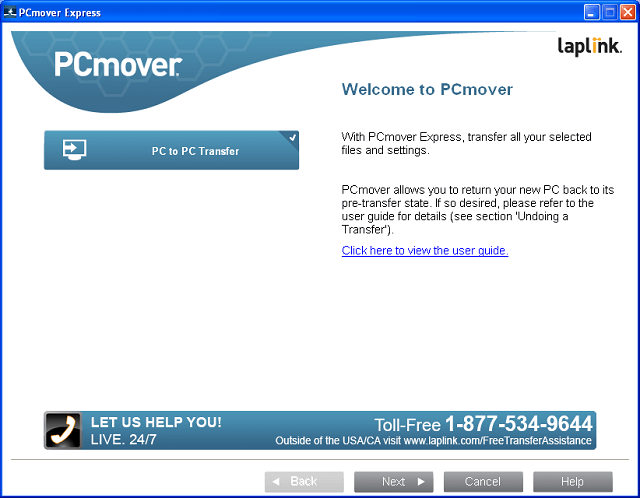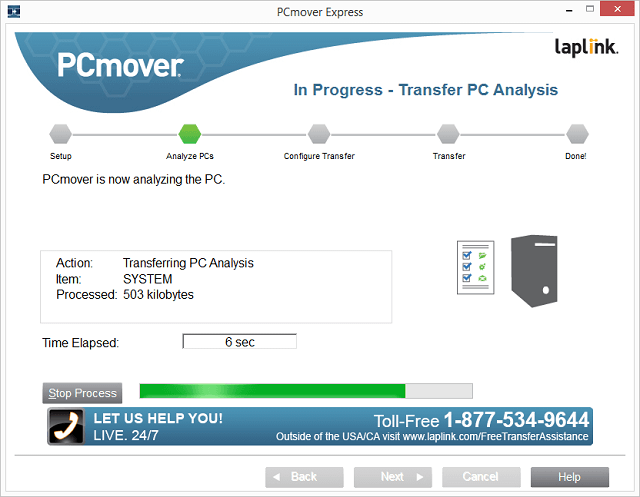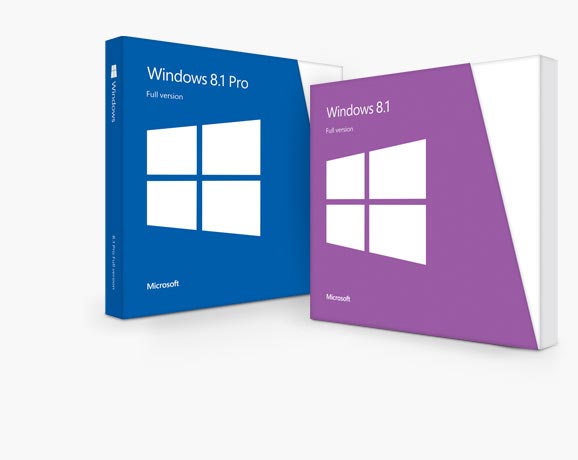On April 8, Microsoft will stop Windows support XP. This means that after more than ten years of existence of this OS, the company will no longer issue security patches, fixes, and provide support, both paid and free.
However, the operating system beloved by millions of users will not stop working, but will become even more vulnerable to viruses, spyware, malware and other attacks. In this regard, Microsoft strongly recommends upgrading to one of the new versions of the operating system - Windows 8 or Windows 7. Many users might be happy to do this, but they are put off by the hassle associated with transferring personal files and settings to new computer. For this reason, Microsoft has partnered with Laplink to offer Windows XP users a simple, fast, and free tool to transfer data to their new PCs.
Before you start, here are some things to keep in mind. As part of the update, we check your current desktop applications and connected devices. We'll let you know what you need to do to get them ready for the update or to get them working again after the update. If you don't want to, you will need to connect again to complete the setup later and the setup will take longer. Temporarily disable your antivirus Some antivirus programs may interfere with installation. In some cases, the installer may find something that you need to take care of before proceeding with the update installation. If for any reason the installation is interrupted, you can restart the update from where you left off by returning to the store and downloading the update again.
- We'll review your desktop apps and devices for you.
- It's best to stay connected until the update is complete.
- Get the latest important and important updates.
- If so, you will see a message telling you what you need to do.
Laplink PCmover Express is a free tool with which anyone can easily transfer their data (documents, photos, music, videos, settings and other files) from an old computer to a new one. To carry out this process, the program must be installed on both source computer(Windows XP) and on the target (Windows 8 or Windows 7). The steps below will show you how to use PCmover Express correctly.
The restart will take longer than usual - 20 minutes to an hour - while the update is applied. You'll see a list of recommended settings called express settings. To accept these settings and continue, select Use Express Settings. You can change any of these settings later after you're done setting up. If you want to change some of these now select "Customize".
What can be transferred from the old OS?
For getting additional information select "Learn more about express settings." You will then be asked to log in. These updates may take a few minutes to download and install, depending on the updates you need. You don't have to wait for applications to complete installation. They will continue to install in background, while you do other things.
Important: PCmover Express will not be able to transfer your programs to your new PC.
Instructions
First, make sure both computers are connected to the same network (WiFi or LAN); Disable your firewall and all security programs. Also, before proceeding, disable any settings (sleep mode, for example) that might cause your PC to shut down during the process.
It's been the biggest shakeup in desktop computing in a while, and even if you're not a user, its big, colorful tiles are on your radar. The changes are subtle, but they are greater than the sum of their parts. The bet is that people will make dramatic changes to the subway without shouting in the other direction. And all it takes is making sure you rejoice at the converts and lure your share of skeptics to the tile side. The default is still your colorful little default landing page, and the traditional desktop still lives behind it.
On a Windows XP computer, launch your browser and go to this web page on the Microsoft website to download PCmover Express.
Install PCmover Express on a computer with Windows XP, as well as on a PC with Windows 8 or Windows 7. The installation is very simple, you just need to press next, next, next... You may also need to install Microsoft Visual C++. If this is your case, simply go to this page to download and install this software.
You still have your spells on the right, your app drawer hiding at the bottom. Which, frankly, they're a hell of a lot better. There will be no retros. You just need to fight a little. But if your muscle memory still pulls you towards that bottom left corner, this is a welcome addition. Instead of just searching your computer, it now includes web search results. And if this information is not relevant to any reason, the traditional results are simply deleted. It's certainly a quirky update, and one that's nice to look at.
Launch PCmover Express, click "Next", then click "PC to PC Transfer", and then click the "Next" button again.

Select the computer (Windows XP) from which you are going to transfer data and click “Next”.

Since you are using free version PCmover Express, select “WiFi or Wired Network” and click “Next” again.
But there are only so many times you need to know the population of New York. Luckily, it's not hard to ignore. This doesn't mean everything is perfect, sometimes apps load more horizontal real estate than you can see in your feed. Sometimes they don't resize to fit what you're doing for them and you end up with a nasty gray space.
The problem here is that some applications are simply not ready for the increase in the number of separated options, and in the meantime they will stick to their 30 or 70 sizes. In theory, things will get better over time, but will likely require updates from app developers.


Install and launch PCmover Express on the new computer, click "Next", select "Windows 8 / Windows 7" and click "Next".

Now select “WiFi or Wired Network” and click the “Next” button.
But still, being able to resize is a big improvement here. Things where disabling one application to a smaller tape just doesn't cut it. The ability to split three apps at once would be even better, but we'll take what we can get.
Updating from media
Subway background to match your desktop. It does a lot to anchor a sense of place. Probably not, but god, it's close. And once you activate it, by holding down a tile, you can drag them around the screen and resize them through the options bar at the bottom.

On the next screen, the program should automatically fill in the name of your Windows XP computer. If this does not happen, on your Windows XP computer, go to the Start menu, click right click mouse on “My Computer”, select “Properties”, go to the “Computer Name” tab and see the full name of your computer. Then go back to the new computer and in PCmover Express enter a name in the "Network Name" field. Now click "Next".
But most importantly, you really can't participate in any apps here, so don't worry about accidentally eating into "Promotions" while you're just trying to uninstall it. The ability to shrink live tiles down to the smallest squares gives you more freedom to pack, if that's your bag. You can also name application groups. But you still can't change the colors of the tiles and can make controlling the freak inside you sad.
The structure behind the scenes appears to be largely identical to the original app, but the interface is much prettier this time around. There aren't many functional differences, but the layout is less dense this time around. The only downside is that you can share things with it from your desktop; you have to be on the subway for this. The first has some hand-wavy controls that could theoretically be useful in the kitchen when your hands are covered in god-knowledge - which, second, is health, diet and exercise information.

Next, the program will begin analyzing your computer, and then prompt you to choose whether to move user accounts from the old PC. I would recommend not to do this, but it's up to you. If you do not want user accounts to be moved to the new computer, click “User Account Selections”, select the account and click “Don’t transfer the user”. Repeat the process for each account and click "Next".
Theoretically useful, but mostly viruses. The last, and probably least, setting is getting a nice facelift in the metro. There are several new options in the new Settings app. For example, if you don't like hot corners, you can disable them without third-party help software. Plus, you can finally give your apps permission to automatic update, and not always wait for your good. You'll also find options to change your default apps for almost everything, maps, mail, music, etc.


At the next stage, a window will appear on the screen that will offer to install additional tools from Microsoft in new system. Simply select “Don’t install any new software on my new PC” and click “Next” to begin the file transfer process.
Quite a bit of. The small changes there, however, add up to excellent additions for people inclined to use them. Boot to your desktop, use that launch button, and you'll be hard pressed to notice the rest. You'll still notice it, but it's easier than ever to push it out. It's also better if you take the metro again.
Or search the Internet from your desktop? There are still problems. And in an update that seems so keen on giving users more options, the deceiver sees that it is missing. This is great, but it becomes a problem if you're rocking two displays, such as a very small but pixel-dense one combined with a larger, less-dense display. choice, you are left with a bad choice. This is an issue that will only affect a subset of users, but it's a noisy subset that cares a lot about it.
Depending on the number of photos, settings and other files, the transfer process may take several hours, and once the process is complete, you will be able to view the report. Then click “Finish” to exit the program and restart your computer.
That's all! If for any reason you change your mind about transferring your files, you can always cancel the process.
It's unintuitive, but it works! The only downside is that the windows will produce a flickering flicker for a second as they jump from one screen to another, but it's better than nothing. We just want to make it a little clearer that this is actually an option somewhere in the window with all the zoom options.
Freeing up disk space
The Start button and boot to desktop are two big wins for hardcore revisionists, but they're probably the last we'll see. The metro is obviously designed for the future not only for mobile devices, and for desktop computers- in any case, the "desktop" continues to exist in the future, and it is not yet clear how well it reconciles both of these worlds. However, we've seen them in action and now we're doing the rollout again with the final version live. So you can either get to the upgrade station now or find another ride.
Have a great day!
Windows 8.1 is now available as a free download for Windows 8 users. Latest version Microsoft's operating system introduces many new features to the platform and includes fixes for most of the problems that users have encountered over the past year.
The chain of start screens can be long, sometimes taking more than a minute to complete. Depending on how slow the system was, it took longer for the desktop to fully load. From there, getting set up is a quick, painless affair.
But in addition to standard passwords you can use the four-digit digital pin to unlock your device. You can make as many gestures as you like, but they have to be marks, circles or palms. In addition to the order, however, you will have to remember where in the picture you should make each gesture. On the one hand, when we set our password with one touch in each corner of the image, we could easily reproduce this pattern even if we didn't click the same pixels every time.
Here's how you can upgrade to Windows 8.1 from any version of Windows:
Windows 8
Make sure you are downloading the new operating system. The Windows 8.1 OS update requires more than 3GB of disk space; make sure you have enough free space on your hard drive before continuing.
Sign in to your Microsoft account. To do this, enter the store, go to the "Delights" menu, select "Settings", click on the "Login" option button and enter. Then select the big tile" Free Update to Windows 8.1" in the Windows Store.
However, when our password was a diagonal slash in each corner, we crossed out, trying to draw lines in the same place as at the beginning. Luckily, when you set up your image password, you'll be asked to repeat the pattern, so if you can't then it might be a sign that you need to come up with something else.
Redesigned Start screen and end of Start button. Moreover, you cannot even interact with these applications in the same way: they run in full screen mode and cannot be minimized or modified like the windows you are used to. As you've probably already heard, the Start button is gone. Well, it's there, but you'll need to hover your mouse over the bottom left corner for it to appear. So it's exactly where you'd expect it to be, it's just hidden until it's clear you need it.
If this option is not available, you need to install everything on your PC Latest updates for your version of Windows. To do this, return to the Delights menu. Next, select "Settings" and then the "Change PC settings" option and click on the " Windows Update". Check for new updates, install them and reboot the system.
In other words, this minimal, unfamiliar screen is the new Start menu. What we can say now that we didn't appreciate then is that while the learning curve is steep, after a while you get comfortable. Nobody is a mannequin: everyone can and will understand this. If you do the same pinch-to-zoom gesture that you use to zoom in and out of web pages, you can shrink the Launch screen to see all of your app pages at a glance. As you can imagine, this is useful if you have a large collection of apps and don't want to navigate horizontally across eight screens at home.
Windows 7
Upgrading to Windows 8.1 from Windows 7 can be done through Microsoft's Upgrade Assistant. Windows 8.1 can be purchased for $119.99, while Windows version 8.1 Pro retails for $199.99. Operating system can be purchased online as a digital copy.
System requirements for Windows 8.1: at least 1 GHz processor, 1 GB random access memory for the 32-bit version or 2 GB of RAM for 64-bit, 16 GB of free hard disk space for 32-bit or 20 GB for 64-bit and a video card that supports Direct X9.
Windows Settings, personal files and most applications are retained when upgrading from Windows 8 to 8.1, however only personal files are retained when upgrading from Windows 7.

Windows XP/Vista
Unfortunately, there is no easy way out for those of you who have been stuck with these versions of Windows. Windows users XP and Vista should do a clean install with DVD Windows 8.1. The operating system can be purchased from Microsoft stores and retail outlets for $119.99 and $199.99 for the Home and Professional versions, respectively.
